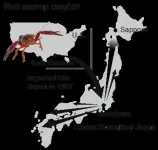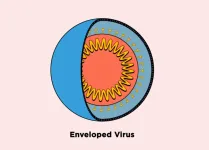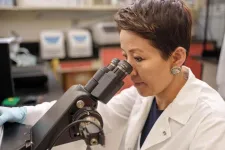(Press-News.org) A non-opioid designer molecule for treating chronic neuropathic pain by calming hyperactive pain-sensing neurons in the peripheral nervous system has had promising results in a preclinical study conducted by researchers at Weill Cornell Medicine and the Burke Neurological Institute.
In the study, published Aug. 2 in the British Journal of Anaesthesia, the first-in-class drug conceptualized by lead author Dr. Gareth Tibbs was found to function according to its design at both the molecular level and as an apparently side-effect-free pain reliever in rats.
“With either a single dose or seven days of daily dosing, we saw a significant reversal of neuropathic pain signs in the rodents,” said co-senior author Dr. Dianna Willis, associate director of the Burke Neurological Institute and an assistant professor of neuroscience in the Feil Family Brain and Mind Research Institute at Weill Cornell Medicine. “We also observed no signs of cardiac side effects, sedation or addictiveness.”
“These are encouraging results, and if further preclinical studies go well, we’ll apply to begin an initial clinical trial,” said the study’s co-senior author Dr. Peter Goldstein, a professor of anesthesiology at Weill Cornell Medicine and an anesthesiologist at NewYork-Presbyterian/Weill Cornell Medical Center.
Neuropathic pain often arises from damage to neurons in the peripheral nervous system, the network of nerves outside of the brain, and is estimated to affect tens of millions of people worldwide. It is notoriously difficult to treat effectively: The current first-line therapies, including the antiepileptic gabapentin and the antidepressant duloxetine, don’t work well and have significant side effects. Opioid painkillers also are relatively ineffective against chronic neuropathic pain and have even worse potential side effects, including addiction and the risk of fatal poisoning.
The new approach arose from a fortuitous convergence of disparate lines of research and a tangential insight based on oceanography.
One critical early observation demonstrated that neuropathic pain arising from hyperexcitability of peripheral neurons is facilitated in part by an abnormal level of activity of a family of proteins, called HCN ion channels, that span the neurons’ cell membrane. HCN1 and HCN2 channels are now considered the most relevant targets for treating peripheral neuropathic pain, but realizing that promise is problematic. HCN2 channels are also widely expressed in heart tissues, and both HCN1 and HCN2 channels are found extensively in the brain. Thus, targeting HCN2, or targeting HCN1 with a drug that enters the brain, could cause significant cardiac or neurological side effects.
Separately, Dr. Goldstein’s group found that the anesthetic propofol, a safe and widely used drug that is commonly thought to act by enhancing the activity of a different class of ion channels called GABAA receptors that inhibit neuronal activity, was also an effective inhibitor of central HCN channels with a strong preference for HCN1.
Based on these discoveries, Dr. Tibbs hypothesized that if an appropriate chemical “anchor” could be tethered to propofol, the molecule would not only be excluded from the brain, but in the periphery it would also function as a “molecular bathysphere.” With the “anchor” trapped outside a cell, the tethered propofol would be free to “sink” into the cellular membrane of a peripheral nerve cell and silence the embedded HCN1 channels.
“In some ways it was a ridiculous idea, but what the current paper shows is that with the right group of collaborators, the ridiculous can become a reality,” said Dr. Tibbs, a senior research associate in anesthesiology at Weill Cornell Medicine. “In so doing, we believe we have created a potential clinical anti-hyperalgesic, paving the way for developing an entire class of novel therapeutics that can be built to target any peripheral membrane-embedded protein of therapeutic interest.”
Based on work Drs. Tibbs and Goldstein published in 2013 and computational modeling and electrophysiological studies, the resultant novel drug, BP4L-18:1:1, has the right molecular properties to be an effective drug. Critically, tests in rodents of an oral formulation, suitable for delivery in pill form, demonstrated effectiveness against neuropathic pain, exclusion from the brain, and a good safety profile.
The project received vital seed funding from the Daedalus Fund for Innovation, a unique de-risking program of Weill Cornell Medicine Enterprise Innovation, as well as from Weill Cornell Medicine’s Department of Anesthesiology. The Cornell Center for Technology Licensing subsequently licensed BP4L-18:1:1 to Akelos, Inc., a development-stage biotech company spun off from Dr. Goldstein’s laboratory in 2018 with the assistance of Weill Cornell Medicine’s innovation ecosystem, to expedite the further development and commercialization of this novel technology.
“The results described in this high impact study exemplify the critical role played by the Daedalus Fund for Innovation, whose mission is to upgrade early-stage technologies and accelerate translation to the point at which they are considered partnership ready and attractive candidates for licensing and commercial development,” said Larry Schlossman, managing director of the Office of BioPharma Alliances and Research Collaborations, who launched and oversees the Daedalus Fund for Innovation. “We look forward to this asset achieving its next value inflection and progressing through each stage of development and commercialization.”
In addition to advancing BP4L-18:1:1 toward human clinical trials, with funding from the National Institutes of Health and Weill Cornell Medicine’s Department of Anesthesiology, Akelos and the research team are investigating strategies for more selectively and potently targeting HCN1 channels.
“Our BP4L-18:1:1 drug candidate has the potential to transform the treatment landscape for millions of people who live with chronic neuropathic pain,” said Akelos founder Dr. Steven Fox. “Unlike addictive narcotics, this molecule actually treats pain at its root cause without any damaging side effects. This milestone study demonstrates vital proof-of-concept and represents a burgeoning new frontier in therapeutics.”
Many Weill Cornell Medicine physicians and scientists maintain relationships and collaborate with external organizations to foster scientific innovation and provide expert guidance. The institution makes these disclosures public to ensure transparency. For this information, see profiles for Drs. Goldstein, Tibbs and Willis.
END
Potential neuropathic pain treatment shows promise in preclinical tests
2023-08-02
ELSE PRESS RELEASES FROM THIS DATE:
Learning how to control HIV from African genomes
2023-08-02
“We searched for human genetic variation that associates with spontaneous control of HIV and identified a novel region in the genome that is only variable in populations of African ancestries,” says Professor Jacques Fellay at EPFL’s School of Life Sciences. “We used a combination of computational and experimental approaches to explore the biological mechanism behind the genetic association and provide evidence that the gene CHD1L acts to limit HIV replication in a subset of white blood cells.”
HIV is still a problem
Despite significant advances in treatment and access to therapy, the ...
How the tropical red swamp crayfish successfully invaded the cold regions of Japan
2023-08-02
Owing to human activities and climate change, many animal species have invaded new habitats. Such biological invasion comes with devastating impacts on the local biodiversity and ecosystems. The red swamp crayfish—known to the scientific world as Procambarus clarkii (P. clarkii)— is no exception. P. clarkii is a freshwater crayfish native to the tropical regions of southern USA and northeastern Mexico. After their introduction to different parts of the world, they have become one of the most widespread and invasive animal species. They are known for their adaptability and aggressive behavior that ensure their survival in a wide range of environments, ...
Breast cancer patients with higher BMI more likely to experience heart damage during chemotherapy
2023-08-02
Breast cancer survival rates have improved considerably in the last few decades in Colombia, but factors that increase the likelihood of patients experiencing cardiovascular side effects, like cardiotoxicity, are not well-known or well-treated. A recent study in the North-East region of Colombia found 11.94% of patients with a high BMI being treated for breast cancer at a regional center experienced heart damage, or cardiotoxicity, during chemotherapy. The study will be presented at the American College of Cardiology (ACC) Latin America 2023 Together with Asociación Costarricense ...
Study presents workaround for randomized experiments
2023-08-02
AUSTIN, Texas – A new statistical tool can help researchers get meaningful results when a randomized experiment, considered the gold standard, is not possible.
Randomized experiments split participants into groups by chance, with one undergoing an intervention and the other not. But in real-world situations, they can’t always be done. Companies might not want to use the method, or such experiments might be against the law.
Developed by a researcher at The University of Texas at Austin, the new tool called two-step synthetic control adapts an existing research workaround, known as the synthetic control method.
The ...
Cal Poly study analyzes nearshore California marine heatwaves and cold spells amid changing climate conditions
2023-08-02
The first-ever study to look at drivers of both marine heatwaves and cold spells in the shallow nearshore along the California Current —coordinated by California Polytechnic State University, San Luis Obispo (Cal Poly) and the Virginia Institute of Marine Science, William & Mary — found that certain environmental conditions and the state of the ocean can lead to an enhanced risk for ocean temperature extremes.
The findings were recently published in Nature Scientific Reports in an article titled “Effects of basin-scale climate modes and upwelling on nearshore marine heatwaves and cold spells in the California Current.”
Extreme ...
Mimicking the body’s own defenses to destroy enveloped viruses
2023-08-02
Just as bacteria can develop antibiotic resistance, viruses can also evade drug treatments. Developing therapies against these microbes is difficult because viruses often mutate or hide themselves within cells. But by mimicking the way the immune system naturally deals with invaders, researchers reporting in ACS Infectious Diseases have developed a “peptoid” antiviral therapy that effectively inactivates three viruses in lab tests. The approach disrupts the microbes by targeting certain ...
Novel molecules fight viruses by bursting their bubble-like membranes
2023-08-02
Antiviral therapies are notoriously difficult to develop, as viruses can quickly mutate to become resistant to drugs. But what if a new generation of antivirals ignores the fast-mutating proteins on the surface of viruses and instead disrupts their protective layers?
“We found an Achilles heel of many viruses: their bubble-like membranes. Exploiting this vulnerability and disrupting the membrane is a promising mechanism of action for developing new antivirals,” said Kent Kirshenbaum, professor of chemistry at NYU and the study’s senior author.
In a new study ...
More than 2,600 health care organizations recognized for commitment to high-quality cardiovascular care
2023-08-02
DALLAS, August 2, 2023 — The American Heart Association, a relentless force for a world of longer, healthier lives, has recognized 2,671 health care and emergency response organizations — nearly 145 more than in 2022 — for their commitment to improving health outcomes for cardiovascular patients through evidence-based efficient and coordinated care.
The American Heart Association’s Get With The Guidelines® and Mission: Lifeline® are hospital-based quality improvement recognition programs that use the latest evidence-based scientific guidelines to save lives and hasten health care recovery ...
Stalking a silent killer
2023-08-02
With a survival rate in the single digits, pancreatic ductal adenocarcinoma (PDAC) is highly lethal. In fact, by the time PDAC is clinically diagnosed, it is already considered incurable via surgery or other means in up to 90% of patients.
Yangzom D. Bhutia, D.V.M., Ph.D., from the Department of Cell Biology and Biochemistry at the Texas Tech University Health Sciences Center (TTUHSC) School of Medicine, has for years focused her research on PDAC. To bolster her efforts, the National Cancer Institute at the National Institutes of Health recently awarded Bhutia a five-year, $1.76 million grant (“SLC6A14 as a unique ...
Many people feel their jobs are pointless
2023-08-02
A sociological study by the University of Zurich confirms that a considerable proportion of employees perceive their work as socially useless. Employees in financial, sales and management occupations are more likely to conclude that their jobs are of little use to society.
In recent years, research showed that many professionals consider their work to be socially useless. Various explanations have been proposed for the phenomenon. The much-discussed “bullshit jobs theory” by the American anthropologist David Graeber, for example, states that some jobs are objectively useless and that this occurs more frequently ...


